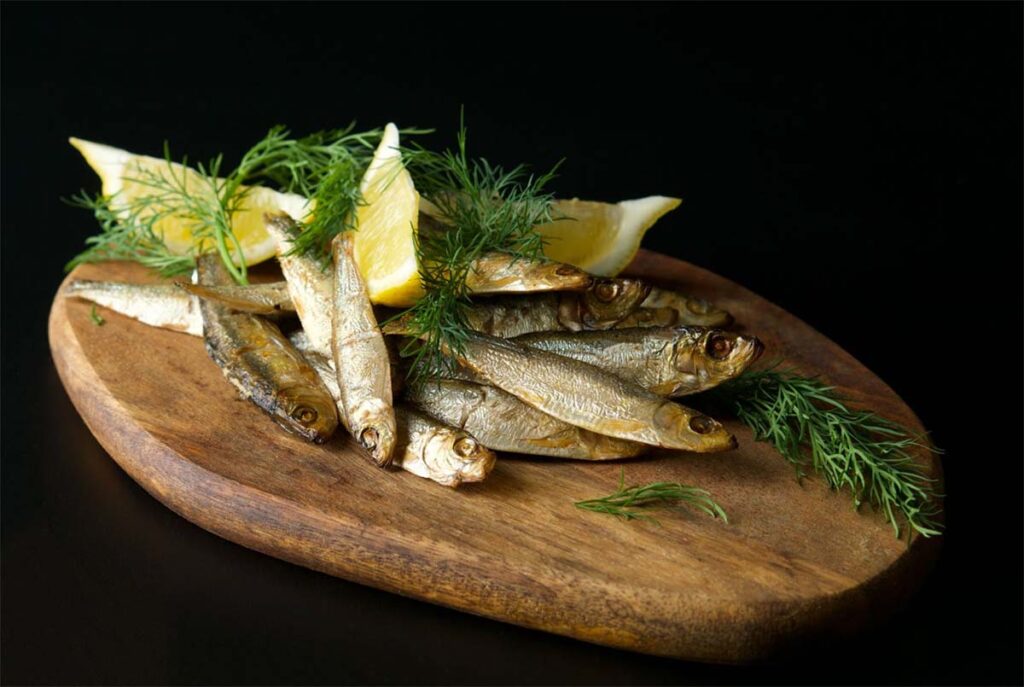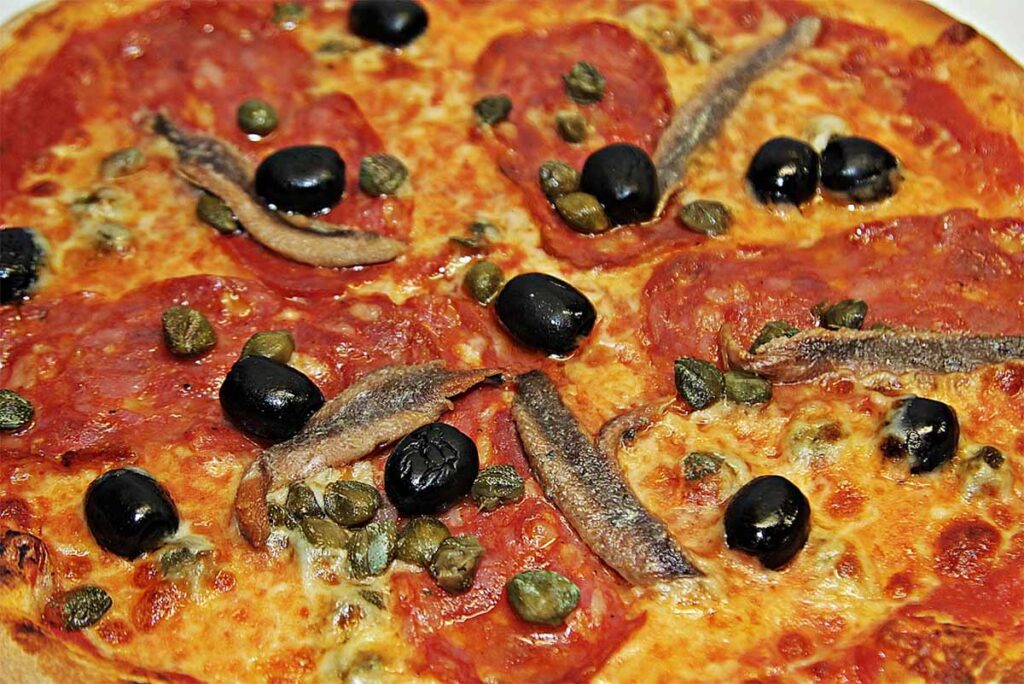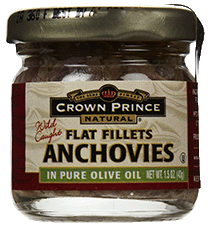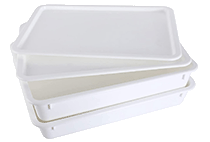Anchovies, these briny little fish, are definitely not everybody’s favorite. But in Mediterranean cooking, these little fish make a big splash. In Italy, anchovies are melted into sauces, chopped into caponata, and layered on thick slides of Sicilian pizza, also known as sfincione.
Table of Contents

In the U.S. midwest, though, many have a real aversion to these flavorful fish preferring lake or river fish. For some reason.
But we think that if only pizza lovers gave anchovies a chance, they would change their minds about this controversial little fish. So we are here to make a case for anchovies on homemade pizza! Say it with us!
Whether you are team anchovy or simply despise them, you really should try them at least once on your homemade pizza, and you may be pleasantly surprised by what these small packages with big flavors are all about. They’re full of umami flavor and totally low-carb and gluten-free.
What Are Anchovies?
Anchovies are small oily fish found in saltwater. Originally found in the Mediterranean and the Black Sea, anchovies are also found in the Atlantic and Pacific waters. These small fish travel in schools and eat plankton.

In the Mediterranean, you can find fresh anchovies in all the markets, and they are often grilled. But in the USA, it’s more common to find them tinned. Because they are small, the bones are soft and easily eaten.
These small fish are nutritional powerhouses with vitamins and minerals, including Omega-3 fatty acids, vitamin B3, and selenium. While they are a healthy source of protein, anchovies are high in sodium because they are tinned in water and salt.
Note: An easy workaround if you are worried about your sodium intake, just rinse the anchovies and dry them on a paper towel to remove excess salt.
Anchovies vs Sardines
Don’t make the mistake of confusing anchovies with sardines, another small fish used in Mediterranean cooking. Sardines are a bit larger than anchovies and don’t have the same intense flavor. You can find them next to each other on supermarket shelves, but understanding the difference is important, and never use them interchangeably.
Anchovies and sardines are two small oily fish that are often used as ingredients in cooking. While they share some similarities, such as their texture and taste, there are also some significant differences between them.
One of the primary differences between anchovies and sardines is their size. Anchovies are typically smaller than sardines, measuring about 3 inches in length, whereas sardines are usually 6 inches long. Due to their size, anchovies have a more concentrated flavor and are much saltier than sardines.
Another difference is their taste. While both fish are oily and have a distinct flavor, anchovies have a stronger and more pungent taste than sardines.
Anchovies are often used to add a briny and savory taste to dishes, while sardines have a milder and more delicate flavor that can complement other ingredients without overpowering them.
Sardines are never eaten on pizza, though. They are often used as a main ingredient in dishes such as salads, sandwiches, and pastas. Consider using them in your appetizers and aperitifs.
How to Use Anchovies in Cooking
Fresh and tinned anchovies are used in many recipes that you probably wouldn’t even suspect. That’s because anchovies don’t have a strong fishy taste or smell.
Instead, they add a salty smack of umami to anything you mix with them. Many chefs use anchovy paste to add a touch of flavor to a surprising number of dishes.

Here are some common ways to use anchovies:
- Pasta sauce
- Mixed in with eggs like in shakshuka
- Salad dressing (usually Caesar but others, too)
- Mashed on toast
- Added to dips and marinades
- Spanish tapas fried anchovies
- And, of course, pizza!
How to Use Anchovies on Homemade Pizza
The first time we tried anchovy pizza, we weren’t sure what to expect and were pleasantly surprised. They add such a nice flavor and are mixed with other ingredients; it’s hard to pick out their distinct flavor.

On pizza, they complement the acidic tomato sauce, and when paired with salty olives, ham, prosciutto, or smoky toppings like grilled peppers and Italian sausage, they create a complexity that is difficult to describe beyond just absolutely delicious.
There are two main ways to use homemade pizza with anchovies. The first is you can mix it into the marinara sauce itself. This is as easy as adding a filet or two and cooking them directly in the sauce. These little guys just dissolve – bodies, bones, and all – into the sauce. They don’t leave any undesired texture, just a lot of flavor.
The other way is to add them as a topping. Just pop open the tin and layer on your pizza. It isn’t common to have a pure classic anchovy pizza. Usually, they are a topping among several on the pizza.
One common way of adding anchovies to pizza in Southern Italy is adding Calabrian chilies, nduja (a spreadable salami), and anchovies. This is a twist on the classic Calabrian pizza. The anchovies give a salty angle to the hot chilies and smoky nduja for an incredible pizza.
What goes well with fish? More fish. Make a seafood pizza with anchovies, shrimp, and smoked oysters. You will love the flavor mix of saltwater treats. If you love a Connecticut clam pizza, swap out the smoked oyster for smoked clams.
For the salt lovers out there, the strongest case for anchovies on homemade pizza is in this salty pizza with capers, anchovies, and olives. This pie tastes best washed down with an ice-cold beer.
Anchovies don’t just combine well with other fish or salty ingredients; try them with smoky sausage and roasted red peppers for a Spanish-inspired pizza.
Other great ways to add anchovies to pizza:
- Capers and tuna
- Sun-dried tomatoes, peppers, mushrooms
- Carmelized onions, pepperoni, and roasted garlic
- Smoky Canadian bacon, anchovies, and pineapple
- Peppery arugula, salty anchovies, sweet pineapple
- Red onions, capers, smoked salmon, and anchovies
Pizza-Inspired Anchovy Appetizers
If you are looking to make anchovy appetizers instead of whole pizzas, there are some unique ways to make anchovy appetizers with pizza flavors. These are great to bring to a potluck or party.
Anchovy bruschetta: Add anchovies to the tomato mixture and drizzle with olive oil.
Anchovy canapes: Spread goat cheese or cream cheese on a cracker and top with anchovy and parsley sprig.
Anchovy and Asiago: Cut a strip of Asiago cheese, add a roasted red pepper, and top with an anchovy filet
Lastly, we wanted to share one of our favorite ways to eat anchovies. We came across it while traveling, and it was amazing. If you are able to find fresh anchovies, you need to try this recipe.
Fried anchovies are a popular tapa or appetizer in Spain. And if you are looking to make an impression, you surely will with this tasty appetizer. Just dredge the anchovies in flour and fry in olive oil.
Serve with marinara sauce or another favorite pizza dipping sauce for a special treat. And don’t forget the wine. We know white wine goes with fish, but because they are fried, red wine is a better choice for sipping while nibbling on fried anchovies.
Have you tried anchovies on pizza? What is your favorite way to eat anchovies?













